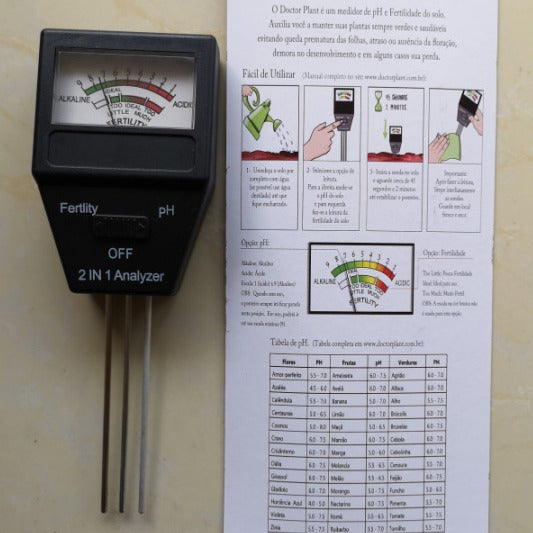Soil Sensor on Gwtech
Two-in-one soil fertility analyzer Soil detector Two-in-one soil fertility meter pH meter
Two-in-one soil fertility analyzer Soil detector Two-in-one soil fertility meter pH meter
Couldn't load pickup availability

How to Analyze Soil Fertility
1. Remove about 5 cm of topsoil, then break up the soil to a depth of 13 cm. Clear away any organic debris that could affect the test results, such as leaves, roots, etc.
2. Soak the soil in water until it becomes muddy (it is best to use rainwater or distilled water).
3. Clean the probe with a clean cotton cloth or tissue.
4. Switch the function button to the first position from the left.
5. Insert the probe into the soil to be tested, ensuring that the distance between the soil and the device body does not exceed 2.5 cm. Wait for a maximum of 10 seconds until the pointer stabilizes, then read the data.
6. Record the data. Remove the probe from the soil and thoroughly clean it.
Analysis Results Criteria
- TOO LITTLE
- Nitrogen: less than 50 ppm
- Phosphorus: less than 4 ppm
- Potassium: less than 50 ppm
- IDEAL
- Nitrogen: 50-200 ppm
- Phosphorus: 4-14 ppm
- Potassium: 50-200 ppm
- TOO MUCH
- Nitrogen: more than 200 ppm
- Phosphorus: more than 14 ppm
- Potassium: more than 200 ppm
*Unit ppm: parts per million*
- If the analysis shows "TOO LITTLE": This indicates a nutrient deficiency. Use liquid fertilizer to replenish nutrients for your plants, following the specific instructions on the fertilizer packaging.
- If the analysis shows "IDEAL": This indicates an ideal range. Apply fertilizer once a month along with irrigation, according to the type of plants you are growing.
- If the analysis shows "TOO MUCH": This indicates an excess of nutrients.
1. Water thoroughly to dilute and wash away excess nutrients.
2. For potted plants, transplant them into new soil.
3. Do not apply any additional fertilizers, but you may add manure, compost, plant debris, leaves, or other organic matter to the soil.
How to Analyze Soil pH
1. Remove about 5 cm of topsoil, then break up the soil to a depth of 13 cm. Clear away any organic debris that could affect the test results, such as leaves, roots, etc.
2. Soak the soil in water until it becomes muddy (it is best to use rainwater or distilled water).
3. Switch the function button to the far-right position.
4. Moisten the probe. Clean the rightmost of the three probes with a cotton cloth.
5. Insert the probe fully into the soil.
6. Wait for 1 minute to read the data.
7. After the test, clean and dry the probe.
Special Tips
- Do not leave the probe inserted in the soil for extended periods of time.
- Do not use this device to test liquids, as it may cause damage.
Share






